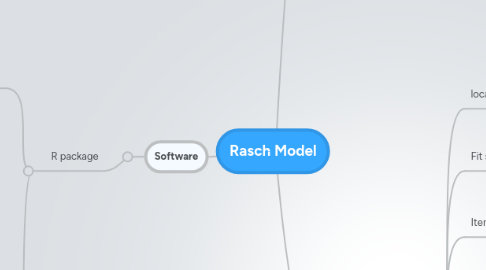
1. Theory
1.1. Basic Assumption
1.1.1. implication assumption
1.1.1.1. local independence
1.1.1.1.1. The prob of an individual's response to an item mus not depend upon the responses of other items
1.1.1.1.2. not depend upon other's response to this item
1.1.1.2. equality of discrimination
1.1.1.2.1. the signal/noise ration represented by the maximum slop of the characteristic curve of each item is assumed to be the same for all items
1.1.1.3. uni-dimensionality
1.1.1.4. no random guessing behavior
1.1.1.5. Invariance
1.1.1.5.1. item difficulty remains the same acorss different groups
1.2. Observation formats
1.2.1. Repeated trails
1.2.1.1. fixed number of independent attempt at each item
1.2.1.2. Rasch 1960
1.2.1.2.1. Andrich 1978
1.2.2. Counts
1.2.2.1. no upper limit on the number of independent successes on an item
1.2.2.2. Rasch
1.2.3. Rating scales
1.2.3.1. a fixed set of ordered response alternatives on each item
1.2.3.2. Andrich 1978
1.2.3.2.1. Masters 1982
1.2.4. Partial Credit
1.2.4.1. requires the prior identification of several ordered levels of performance on each item, free to vary in number and structure
1.2.4.2. Masters 1982
1.3. Adventage
1.3.1. the only latent trait model for which the response is a sufficient statistic for person parameteres, permit the elimination of the person parameteres from the estimation equation for items
2. Rasch Analysis
2.1. local dependence
2.1.1. residual correlation
2.1.1.1. chi square no more than 0.2
2.1.1.1.1. dependency solution: removing items or creating of correlating items
2.2. Fit statistics
2.2.1. interaction
2.2.1.1. item-person interaction
2.2.1.1.1. should have a mean around 0 adn sd 1
2.2.1.2. item-trait interaction
2.2.1.2.1. chi-square
2.3. Item probability curve analysis
2.3.1. step estimation location
2.3.1.1. reversed or disordered thresholds
2.3.1.1.1. Solution : can collapse the response options
2.3.2. surface of
2.4. Internal reliability studies
2.4.1. Person Seperation Index (PSI)
2.4.1.1. >0.7 : consistent with the scale
2.4.2. Cronbach alpha
2.5. Sample size
2.5.1. a sample size of 250 is needed to obtain a 99% confidence with a stable item calibration within 0.5 logits
2.5.1.1. by Linacre
2.6. Unidimensionality
2.6.1. Compare two subset of items identified by PCA with t test
2.6.1.1. if 95% CI of t test include 5%, unidimention
2.7. invariance
2.7.1. Differential Item Functioning DIF
2.7.1.1. examine DIF between groups such as gender, age
2.7.1.1.1. if too big,remove the item
2.8. Responsiveness
2.8.1. Standardised Resonse Means (SRM)
2.8.1.1. compare the ordinal scores data and interval data
2.9. item/person fit
2.9.1. mean fit residual should be within the range of +/- 2.5
2.9.2. mean fit residual statistics shoud be close to 0 with sd 1
2.9.3. item should show non-significant chi-square
2.10. Targeting
2.10.1. the mean location for persons of a well-targeted measure is expected to be around zero
3. Software
3.1. R package
3.1.1. eRm
3.1.1.1. Rasch analysis
3.1.1.1.1. Test
3.1.1.1.2. Plot
3.1.1.2. Model
3.1.1.2.1. RM, RSM, PCM
3.1.1.2.2. Linear Model: LLTM,LRSM,LPCM
3.1.2. ltm
3.1.2.1. model
3.1.2.1.1. dichotomous data
3.1.2.2. Test
3.1.2.2.1. rasch()
3.1.2.3. Rasch analysis
3.1.2.3.1. Gof.rasch()

